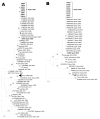Enterovirus co-infections and onychomadesis after hand, foot, and mouth disease, Spain, 2008
- PMID: 22172227
- PMCID: PMC3311182
- DOI: 10.3201/eid1712.110395
Enterovirus co-infections and onychomadesis after hand, foot, and mouth disease, Spain, 2008
Abstract
Hand, foot, and mouth disease (HFMD), a common disease caused by enteroviruses (EVs), usually affects children. Clustered and sporadic HFMD cases, followed by onychomadesis (nail shedding), occurred during summer and fall 2008 in Valencia, Spain. Fecal samples from onychomadesis patients, who did or did not have previous HFMD, and from healthy children exposed to onychomadesis patients tested positive for EV. The complete viral protein 1 capsid gene sequence was obtained for typing and phylogenetic analysis. Two EV serotypes, coxsackievirus A10 and coxsackievirus B1 (CVB1), were mainly detected as a monoinfection or co-infection in a childcare center where an onychomadesis outbreak occurred. On the basis of our results, and detection of CVB1 in 2 other contemporary onychomadesis outbreaks in childcare centers in Spain, we propose that mixed infection of an EV serotype that causes HFMD, plus the serotype CVB1, could explain the emergence after HFMD of onychomadesis, a rare and late complication.
Figures



References
-
- Khetsuriani N, Lamonte-Fowlkes A, Oberst S, Pallansch MA. Enterovirus surveillance—United States, 1970–2005. MMWR Surveill Summ. 2006;55:1–20. - PubMed
-
- International Committee on Taxonomy of Viruses. ICTV master species list 2009, version 8. [updated 2010 December 9] [cited 2009 Mar 26]. http://talk.ictvonline.org/files/ictv_documents/m/msl/1231.aspx
-
- Pallansch MR. Polioviruses, coxsackieviruses, echoviruses, and newer enteroviruses. In: Knipe DM, Howley PM, editors. Fields virology. 5th ed. Philadelphia: Lippincott Williams & Wilkins; 2007. p. 839–93.
-
- Ang LW, Koh BK, Chan KP, Chua LT, James L, Goh KT. Epidemiology and control of hand, foot and mouth disease in Singapore, 2001–2007. Ann Acad Med Singapore. 2009;38:106–12. - PubMed
Publication types
MeSH terms
Substances
LinkOut - more resources
Full Text Sources
Medical
Research Materials
